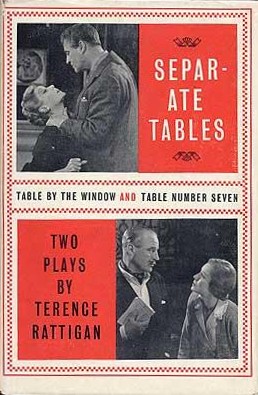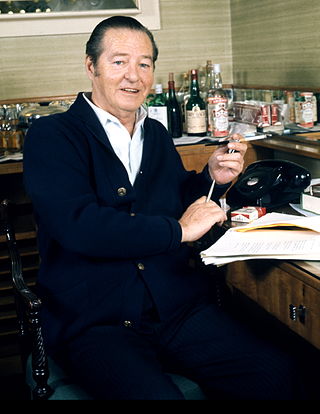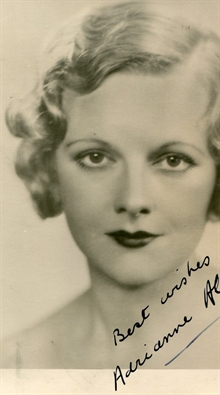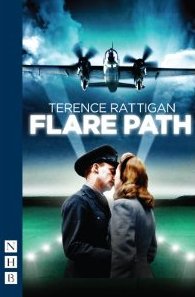
Separate Tables is the collective name of two one-act plays by Terence Rattigan, both taking place in the Beauregard Private Hotel, Bournemouth, on the south coast of England. The first play, titled Table by the Window, focuses on the troubled relationship between a disgraced Labour politician and his ex-wife. The second play, Table Number Seven, is set about 18 months after the events of the previous play, and deals with the touching friendship between a repressed spinster and Major Pollock, a kindly but bogus man posing as an upper-class retired army officer. The two main roles in both plays are written to be played by the same performers. The secondary characters – permanent residents, the hotel's manager, and members of the staff – appear in both plays. The plays are about people who are driven by loneliness into a state of desperation.

Sir Terence Mervyn Rattigan was a British dramatist and screenwriter. He was one of England's most popular mid-20th-century dramatists. His plays are typically set in an upper-middle-class background. He wrote The Winslow Boy (1946), The Browning Version (1948), The Deep Blue Sea (1952) and Separate Tables (1954), among many others.

The Browning Version is a play by Terence Rattigan, seen by many as his best work, and first performed on 8 September 1948 at the Phoenix Theatre, London. It was originally one of two short plays, jointly titled "Playbill"; the companion piece being Harlequinade, which forms the second half of the evening. The Browning Version is set in a boys' public school and the Classics teacher in the play, Crocker-Harris, is believed to have been based on Rattigan's Classics tutor at Harrow School, J. W. Coke Norris (1874–1961).
Sir Trevor Robert Nunn is an English theatre director. He has been the artistic director for the Royal Shakespeare Company, the Royal National Theatre, and, currently, the Theatre Royal Haymarket. He has directed dramas for the stage, like Macbeth, as well as opera and musicals, such as Cats (1981) and Les Misérables (1985).

The Deep Blue Sea is a British stage play by Terence Rattigan from 1952. Rattigan based his story and characters in part on his secret relationship with Kenny Morgan, and the aftermath of the end of their relationship. The play was first performed in London on 6 March 1952, directed by Frith Banbury, and won praise for actress Peggy Ashcroft, who co-starred with Kenneth More. In the US, the Plymouth Theater staged the play in October 1952, with Margaret Sullavan. The play with Sullavan subsequently transferred to Broadway, with its Broadway premiere on 5 November 1953, and running for 132 performances.

The Theatre Royal Haymarket is a West End theatre on Haymarket in the City of Westminster which dates back to 1720, making it the third-oldest London playhouse still in use. Samuel Foote acquired the lease in 1747, and in 1766 he gained a royal patent to play legitimate drama in the summer months. The original building was a little further north in the same street. It has been at its current location since 1821, when it was redesigned by John Nash. It is a Grade I listed building, with a seating capacity of 888. The freehold of the theatre is owned by the Crown Estate.

James Brian Mark Purefoy is an English actor. He played Mark Antony in the HBO series Rome, Nick Jenkins in A Dance to the Music of Time, college professor turned serial killer Joe Carroll in the series The Following, Solomon Kane in the film of the same name, and Hap Collins in the Sundance series Hap and Leonard. In 2018, he starred as Laurens Bancroft in the first season of Altered Carbon, a Netflix original series. Following an uncredited role as V in the 2006 film V for Vendetta, he was cast as Captain Gulliver "Gully" Troy / Captain Blighty in the 2020–2021 second and 2022 third season of the Gotham and V for Vendetta prequel television series, Pennyworth, in a main role.

Sheridan Caroline Sian Smith OBE is an English actress, singer, and television personality. Smith came to prominence after playing a variety of characters on sitcoms such as The Royle Family (1999–2000), Two Pints of Lager and a Packet of Crisps (2001–2009), Gavin & Stacey (2008–2010), and Benidorm (2009). She played the role of Joey Ross on the drama series Jonathan Creek (2009–2013) and went on to receive acclaim for starring in a succession of television dramas, such as Mrs Biggs (2012), Cilla (2014), The C Word (2015), Black Work (2015), and The Moorside (2017). Her feature film credits include Tower Block (2012), Quartet (2012), and The Huntsman: Winter's War (2016).

The Way to the Stars is a 1945 Anglo-American black-and-white Second World War drama film made by Two Cities Films. The film was produced by Anatole de Grunwald, directed by Anthony Asquith, and stars Michael Redgrave, John Mills, Rosamund John, and Stanley Holloway. In the United States it was shortened by 22 minutes, and the shortened version was distributed by United Artists under the title Johnny in the Clouds.

Leslie Gilbert Dwyer was an English film and television actor.

Joe Armstrong is an English actor. His notable television roles include Allan A Dale in three series of Robin Hood, Hotspur in Henry IV, Part I, Ashley Cowgill in Happy Valley and Bairstow in The Village. On stage, he played the lead role in D. C. Moore's The Empire and appeared in the 2011 revival of Flare Path. He co-starred with Maxine Peake in Miss Julie at the Royal Exchange and with Louise Brealey in a touring production of Constellations.
Clive Wood is a British actor, known for his television roles in Press Gang (1989–93), The Bill (1990), London's Burning (1996–99), and as King Henry I in The Pillars of the Earth (2010). His stage roles include playing Stephano in The Tempest at Shakespeare's Globe (2011) and Antony in Antony and Cleopatra at the Haymarket (2014). His film appearances include The Innocent (1985), Buster (1988) and Suffragette (2015).
Peter Glenville was an English film and stage actor and director.

Adrianne Allen was an English stage actress.
Mark Lee Dexter is an English actor who trained at RADA.
Robin Midgley was a director in theatre, television and radio and responsible for some of the earliest episodes of Z-Cars and for the television version of the Royal Shakespeare Company's Wars of the Roses.
Harry Frederick Gerard Hadden-Paton is a British actor. He is perhaps best known for his television roles as Herbert Pelham, 7th Marquess of Hexham, in the television series Downton Abbey and Martin Charteris in The Crown.
Matthew Tennyson is an English actor of stage and screen. He won the Evening Standard Award for Outstanding Newcomer in 2012.

Beryl Measor was a British actress. She created roles in plays by Noël Coward and Terence Rattigan. In addition to her stage career she broadcast frequently on BBC radio and television, and appeared in several cinema films.
Emma Handy is a British actress best known for her West End stage work and her role as DC Paula McIntyre in the ITV1 award-winning drama series Wire in the Blood in which she appeared for five series.












